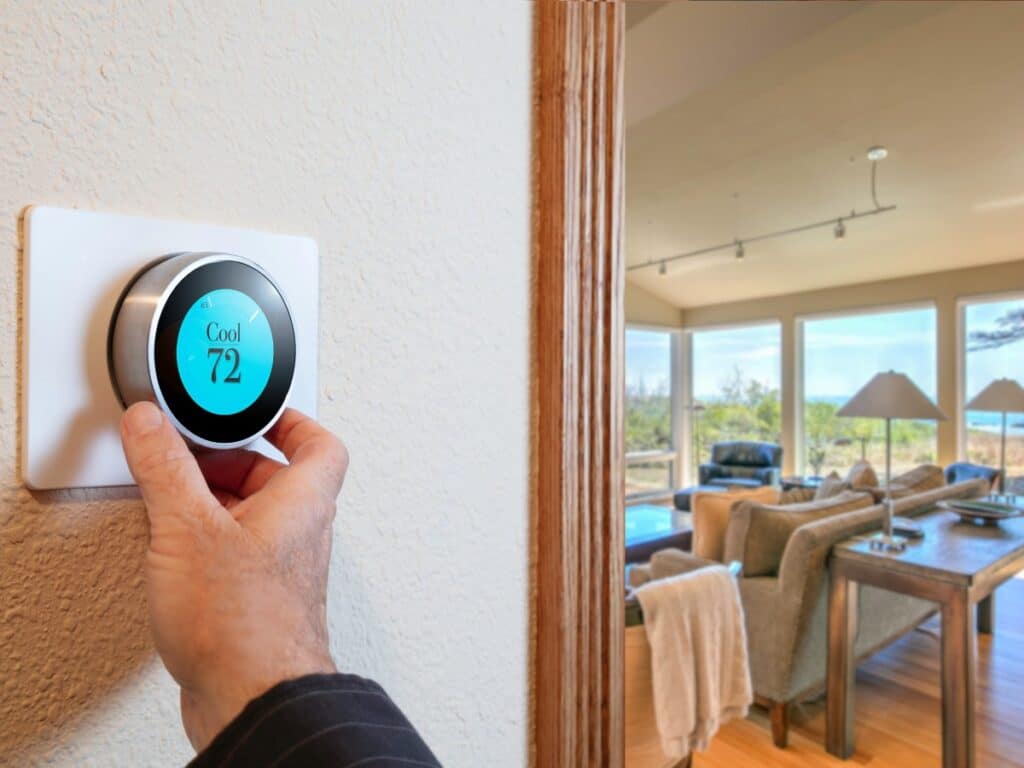Smart thermostats have become increasingly popular in recent years, and for good reason. These innovative devices offer many benefits that can improve your home’s comfort, energy efficiency, and convenience. From saving you money on your energy bills to providing remote control capabilities, smart thermostats are revolutionizing how we heat and cool our homes.
Gone are the days of manually adjusting the temperature on your thermostat. With a smart thermostat, you can easily control your home’s temperature settings through a smartphone app, even when you’re away. This means you can adjust the temperature to your liking before you arrive home or save energy by lowering the temperature when you’re not there.
In this comprehensive guide, we will detail the various benefits of smart thermostats. From enhanced energy efficiency to detailed energy usage reports, we will explore how these devices can enhance your home’s heating and cooling system. So, let’s uncover the many benefits of smart thermostats and how they can transform your home.
Unveiling the Benefits of Smart Thermostats: A Detailed List
Smart thermostats offer many benefits that enhance your home’s heating and cooling system. By taking advantage of advanced technology and automation, these devices can help you save energy, improve comfort, and reduce energy bills. From enhanced energy efficiency to remote control capabilities, let’s explore the detailed benefits that smart thermostats offer.
1. Enhanced Energy Efficiency for Cost Savings
One of the key benefits of smart thermostats is their ability to enhance energy efficiency, leading to significant cost savings on your energy bills. These devices use advanced algorithms and occupancy sensors to learn your schedule and adjust the temperature accordingly. By automatically turning off the heat or AC when you’re not at home, smart thermostats help you save energy without sacrificing comfort. In fact, according to the Environmental Protection Agency, smart thermostats that meet Energy Star criteria can save users an average of 8% on their utility bills. This translates to significant savings over time, especially in places with extreme weather conditions or high energy prices. So, by investing in a smart thermostat, you can reduce your carbon footprint and enjoy a noticeable decrease in your energy bills.
2. Remote Control via Smartphone Apps
Gone are the days of manually adjusting your thermostat. With a smart thermostat, you can control your home’s temperature settings from anywhere using a smartphone app. Whether at work, on vacation, or simply lounging on the couch, you can easily adjust the temperature with a few taps on your phone. This remote control capability offers a high level of convenience and flexibility, allowing you to ensure your home is at the perfect temperature whenever you need it. You only need an internet connection and a compatible smartphone app to access and control your smart thermostat. So, no matter where you are, you can enjoy the comfort and convenience of a well-regulated home environment.
3. Learning Your Schedule for Optimized Heating and Cooling
Smart thermostats take comfort and energy efficiency to the next level by learning your schedule and adjusting the temperature accordingly. Using advanced algorithms and occupancy sensors, these devices can determine when you’re home and when you’re away. Smart thermostats optimize your heating and cooling system by analyzing your daily patterns and occupancy to ensure comfort and energy savings. For example, when the thermostat senses that your house is empty, it can switch to an energy-saving mode that adjusts the temperature to save energy. And when it detects that you’re about to arrive home, it can pre-cool or pre-heat your home to your preferred temperature. This intelligent scheduling feature saves energy and ensures that your home is always comfortable when you need it.
4. Detailed Energy Usage Reports
Smart thermostats provide detailed energy usage reports, giving insights into your home’s energy consumption. These reports can help you understand how much energy your heating and cooling system uses and identify areas where you can adjust to save energy. Additionally, smart thermostats can provide information on your energy profile, such as peak usage times and patterns. This allows you to make informed decisions about energy usage and adjust your habits accordingly. Here are some key features of the detailed energy usage reports provided by smart thermostats:
- Energy usage data: Analyze your energy usage by day, week, month, or year.
- Energy profile: Understand your home’s energy consumption patterns and identify opportunities for energy savings.
- Cooling system efficiency: Monitor the efficiency of your cooling system and identify any potential issues or maintenance needs.
5. Maintenance Alerts and Diagnostic Reports
Smart thermostats help you save energy and provide valuable maintenance alerts and diagnostic reports for your HVAC system. These alerts and reports can help you stay on top of your system’s health and address any potential issues before they become significant problems. Here are some key benefits of the maintenance alerts and diagnostic reports offered by smart thermostats:
- Maintenance alerts: Receive notifications when it’s time to replace your HVAC filter or schedule routine maintenance for your system.
- Diagnostic reports: Get detailed insights into your HVAC system’s performance, including information on temperature differentials, fan speeds, and system runtimes.

Maximizing Your Smart Thermostat
A smart thermostat provides numerous benefits for your home, but to truly maximize its potential, you should follow a few best practices. By implementing these tips, you can ensure that your smart thermostat operates efficiently, saves energy, and optimizes your home’s comfort and convenience. Let’s explore some essential tips for maximizing your smart thermostat’s effectiveness:
Tips for Installing Your Smart Thermostat
Installing a smart thermostat is relatively straightforward, but there are a few essential considerations to remember to ensure a successful installation. Here are some tips to help you install your smart thermostat properly:
- Check compatibility: Before purchasing a smart thermostat, ensure it’s compatible with your heating and cooling system. Check the manufacturer’s website or consult a professional if you need clarification.
- Ensure a stable Wi-Fi connection: Smart thermostats require a stable Wi-Fi connection for remote control capabilities and software updates. Ensure your Wi-Fi signal is robust and reliable in the area where the thermostat will be installed.
- Follow the manufacturer’s instructions: Each smart thermostat may have specific installation instructions, so read and follow the manufacturer’s guidelines carefully.
- Consider professional installation: If you’re uncomfortable with DIY installation or have a complex HVAC system, hiring a professional to install your smart thermostat may be best.
Best Practices for Setting Up Schedules and Preferences
Setting up schedules and preferences is an essential part of maximizing the effectiveness of your smart thermostat. You can optimize your comfort and energy savings by customizing your settings to align with your lifestyle and preferences. Here are some best practices for setting up schedules and preferences on your smart thermostat:
- Understand your daily routine: Consider your daily routine and occupancy patterns to create a schedule that aligns with your lifestyle. For example, the thermostat can be programmed to lower the temperature during work hours when no one is home.
- Optimize temperature settings: Experiment with different temperature settings to find your home’s most comfortable and energy-efficient range. Adjust the temperature gradually and observe how it affects your comfort and energy usage.
- Utilize vacation mode: If you’re going on vacation or will be away from home for an extended period, activate the vacation mode on your smart thermostat to save energy.
Troubleshooting Common Issues
While smart thermostats offer numerous benefits, occasionally, you may encounter some common issues. Understanding how to troubleshoot these issues can help you quickly resolve any problems and ensure the smooth operation of your smart thermostat. Let’s explore some common issues you may face with a smart thermostat and how to address them.
Solving Connectivity Problems
Connectivity problems are one of the common issues that smart thermostat users may encounter. If you’re experiencing connectivity issues with your smart thermostat, here are some troubleshooting steps you can take:
- Check your internet connection: Ensure your Wi-Fi router is working correctly and providing a stable internet connection.
- Reset your smart thermostat: Try resetting it by turning it off and on again. This can sometimes resolve connectivity issues.
- Reconnect your smart thermostat to your Wi-Fi network: Follow the manufacturer’s instructions to reconnect your smart thermostat to your Wi-Fi network.
Addressing Compatibility Concerns with HVAC Systems
Compatibility concerns can arise when installing a smart thermostat with specific HVAC systems. If you’re unsure whether your HVAC system is compatible with a smart thermostat, here are a few steps you can take:
- Check the manufacturer’s compatibility list: Smart thermostat manufacturers often provide a list of compatible HVAC systems on their website. Check this list to see if your system is supported.
- Consult a professional: If you need more clarification about compatibility, it’s best to consult a professional HVAC technician who can assess your system and recommend compatible smart thermostat options.
- Consider retrofit options: In some cases, retrofit options may be available to make your HVAC system compatible with a smart thermostat. Consult a professional to determine whether this solution is viable for your system.
Frequently Asked Questions
How Much Can You Save with a Smart Thermostat?
The money you can save with a smart thermostat depends on various factors, such as your heating and cooling usage, energy prices, and climate. Smart thermostats meeting Energy Star criteria can save users around 8% on their utility bills. This translates to approximately $50 in annual savings for the average American household.
Are Smart Thermostats Difficult to Install?
The installation process for a smart thermostat can vary depending on your HVAC system and technical expertise. While some homeowners may find it relatively straightforward, others may prefer to hire a professional. For a successful installation, it’s essential to follow the manufacturer’s instructions and ensure compatibility with your HVAC system.

